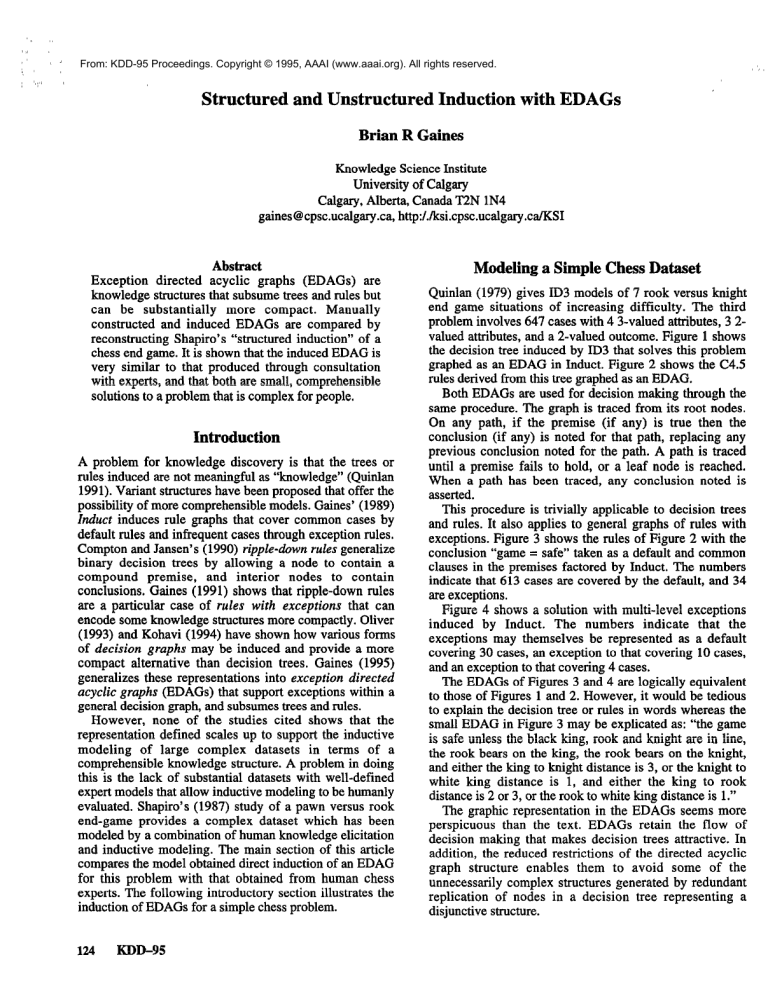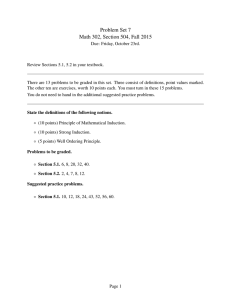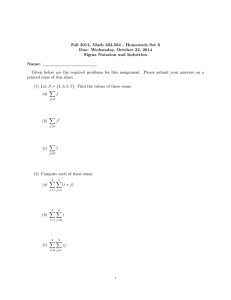
From: KDD-95 Proceedings. Copyright © 1995, AAAI (www.aaai.org). All rights reserved.
Structured and Unstructured Induction with EDAGs
Brian R Gaines
KnowledgeScienceInstitute
University of Calgary
Calgary, Alberta, CanadaT2N lN4
gaines@cpsc.ucalgary.ca,
http:/./ksi.cpsc.ucalgary.ca/KSI
Abstract
Exception directed acyclic graphs (EDAGs) are
knowledge structuresthat subsumetrees and rules but
can be substantially more compact. Manually
constructed and induced EDAGs are compared by
reconstructing Shapiro’s “structured induction” of a
chessend game.It is shown that the inducedEDAG is
very similar to that produced through consultation
with
and that both are small.
_----.__,comorehensible
- ----=--------------- exnerts
- .-=-- .-; -.--solutions to a problem that is complex for people.
Introduction
A problem for knowledge discovery is that the trees or
rules induced are not meaningful as “knowledge”(Quinlan
1991).Variant structureshave beenproposedthat offer the
possibility of more comprehensiblemodels. Gaines’(1989)
Induct induces rule graphs that cover common cases by
default rules and infrequent casesthrough exceptionrules.
Compton and Jansen’s(1990) ripple-down &es generalize
binary decision trees by allowing a node to contain a
compound premise, and interior nodes to contain
conclusions. Gaines (1991) shows that ripple-down rules
are a particular case of rules with exceptions that can
encodesomeknowledge structuresmore compactly. Oliver
(1993) and Kohavi (1994) have shown how various forms
of decision graphs may be induced and provide a more
compact alternative than decision trees. Gaines (1995)
generalizesthese representationsinto exception directed
acyclic graphs (EDAGs) that support exceptions within a
generaldecision graph, and subsumestreesand rules.
However, none of the studies cited shows that the
renresentation
_- ______ wales
L-----=---_____-__ defined
un
-= to
_- ‘wnnort
-rr-‘-
the
____ inductive
___--___. -
modeling of large complex datasets in terms of a
comprehensibleknowledge structure. A problem in doing
this is the lack of substantial datasetswith well-defined
expert models that allow inductive modeling to be humanly
evaluated. Shapiro’s (1987) study of a pawn versus rook
end-game provides a complex dataset which has been
modeled by a combination of human knowledgeelicitation
and inductive modeling. The main section of this article
comparesthe model obtaineddirect induction of an EDAG
for this problem with that obtained from human chess
experts. The following introductory section illustrates the
induction of EDAGs for a simple chessproblem.
124
KDD-95
Modeling a Simple Chess Dataset
._^-^.
Quinian (1Y7Y)gives ID3 modeis of 7 rook versus knight
end game situations of increasing difficulty. The third
problem involves 647 caseswith 4 3-valued attributes, 3 2valued attributes, and a 2-valued outcome. Figure 1 shows
the decision tree induced by ID3 that solves this problem
graphedas an EDAG in Induct. Figure 2 shows the C4.5
rules derived from this tree graphedas an EDAG.
Both EDAGs are used for decision making through the
same procedure.The graph is traced from its root nodes.
On any path, if the premise (if any) is true then the
conclusion (if any) is noted for that path, replacing any
previous conclusion noted for the path. A path is traced
until a premise fails to hold, or a leaf node is reached.
When a path has been traced, any conclusion noted is
asserted.
This r--~
Drocedure
trees
--rr~ ~---~~ to decision
-~~~ is trividiv 6 aDDlicable
and rules. It also armlies to general graphs of rules with
exceptions.Figure 3lshows the rules of Figure 2 with the
conclusion “game = safe”taken as a default and common
clauses in the premises factored by Induct. The numbers
indicate that 613 casesare covered by the default, and 34
are exceptions.
induced by Induct. The numbers indicate that the
exceptions may themselves be represented as a default
covering 30 cases,an exception to that covering 10 cases,
and an exceptionto that covering 4 cases.
The EDAGs of Figures 3 and 4 are logically equivalent
to those of Figures 1 and 2. However, it would be tedious
to explain the decision tree or rules in words whereasthe
small EDAG in Figure 3 may be explicated as: “the game
:.. ,.-AL
&La
IA..,
-,A 1.~:A.,
^-a :,111,:..a
15
SialG..-I,..LlIUFiSS
“IL: Ll,,1.
“lL%GlL
lull& -.,l.
‘““IL al.LIU
nrll~;llr zllc
Il‘lG,
the rook bears on the king, the rook bears on the knight,
and either the king to knight distance is 3, or the knight to
white king distance is 1, and either the king to rook
distanceis 2 or 3, or the rook to white king distanceis 1.”
The graphic representationin the EDAGs seemsmore
perspicuous than the text. EDAGs retain the flow of
decision making that makes decision trees attractive. In
addition, the reduced restrictions of the directed acyclic
graph structure enables them to avoid some of the
unnecessarilycomplex structures generatedby redundant
replication of nodes in a decision tree representing a
disjunctive structure.
-> aeme= safe
Figure 1 ID3 decision tree solving a rook versus knight chessend game problem
(-,)
line=t
r>zk = t
rx-n = t
k-r = 2
n-wk = 1
-> game = lost
cl
(-,)
(E)
(,)
-> cwne = lost
I
-> game = lost
line = t
r>>k = t
rx-n = t
line = t
r>>k = t
r>>n = t
k-r = 3
k-n = 3
-z aame = lost
I I
Figure 2 C4.5 rules derived from the decision tree of Figure 1
->game = safe
613
Figure 3 Induct factorization of C4.5 rules
Figure 4 Induct rules with exceptions
Gaines
125
Comparing Elicited and Induced Structures
How do the results of the previous section scale up to a
more complex situation? Shapiro (1987) studied a situation
in the rook versus pawn (KPa7KR) end-game situation
which he notesis poorly documentedin the chessliterature.
The white pawn is at a7, able to queen,and the black rook
and the two kings are in any of the 209,718 legal
configurations of which 129,825 are classified won-forwhite and 79,893 are classified not-won-for-white.
In the chess situations studied by Quinlan and Shapiro
the board positions of the pieces are well-defined but the
attributes that a chess expert uses in assessing those
positions are not. Hence, human experts were interviewed
to elicit those characteristicsof the situations that they saw
as significant to making a decision about whetherthe game
was won or not. Quinlan’s studies elicited theseattributes,
applied them to a set of situations where the outcome was
known, and then used ID3 to develop a decision tree which
would be totally correct if the attributes adequately
characterizedthe problem.
Shapiro’s study addressed the problem noted in the
introduction, that the resultant decision trees, although
correct, could not be regarded as demonstrating
“lrnn~wld~~”
R.&V” nAagu
“Inf
ehmnn
V.I”Y.7.
UP LlUU
harl lll”UU
c-baa.
11”
z.=vnm+z
vILyY..u
nnrtitinn
pu&ILI”~.
ICZar
Structured Induction using Decision Trees
Figure 5 is reproducedfrom Shapiro’s book and shows the
structure of his solution in terms of the attributes used to
develop the 9 sub-trees.Each circle representsa decision
tree with between 4 and 7 attributes, and the complete
structurehas 122 nodes.
Figure 6 shows the top-level decision tree, pa7 in Figure
5. It involves the introduction of intermediate decision
variables, such as ds (good delayed skewer threat) and dq
(simple delay to queening), which are computed through
other decision trees.
thkp
U.”
problem situation and define small sub-problems,each of
which defined a new decision variable. He defined “small”
to mean that the sub-problemcould be solved using fewer
than 7 attributes, each of which could be derived from a
board position with less than a “screenfull of C code.”For
each sub-problem, he classified the databaseof cases in
terms of the small set of attributes and the decision
variable, and then used ID3 to develop a decision tree.
Ibkxwpj
Shapirotermed this technique“structured induction” and
used it to develop a complete solution of the KPa7KR endgame in terms of 9 sub-problemsintroducing 8 additional
decision variables.The total number of attributesdefined is
35 binary and 1 ternary, and the total number of different
attribute vectors involved is 3,196. This datasetis available
through the University of Irvine archive (Murphy and Aha
1994),and hasbeenusedin other studies(Muggleton 1987;
Holte, Acker and Porter 1989).
--> game = won
Figure 6 Top-level tree pa7 (Shapiro 1987)
1
Figure 5 Structured induction of solution to a chessend game (Shapiro 1987)
126
KDD-95
Structured Induction using EDAGs
Shapiro’s use of decision trees reflects the representational
nnl.amn
Dc.‘IsxlIa
,..,:1,l.1,.
ca”QLIcl”IG
.r.
I.”
I.::.. A.,
111111 111 lllci
. . ..“I..
Gsuly
1nor-L
170”s.
TLA
lIlC
n
7
^..L
Ml”-
problem trees are themselvesfairly difficult to understand,
and are incomprehensible when combined into a single
knowledge structure. As a first experiment ID3 was
replaced with Induct and an EDAG induced for each subproblem as shown in Figure 7. Enclosureshave beenadded
to show the sub-problemsand their relationships. A nested
EDAG computesan intermediatedecision variable used by
the EDAG at the level of nesting above.
It can be seen at the bottom right that the game is won
unlessthe black rook cannot be capturedsafely (rimmx = f)
and either there is a simple delay to queening (dq = t) or
one or more black pieces controls the queening square
(bxqsq = t), or the white king is in stalemate(stlmt = t), or
there is a good delayedskewer threat (ds = t). It can be seen
at the bottom left that there is a good delayed skewer threat
(ds = t) if there is a special opposition pattern (spcop = t),
or a combination of 5 other attributes have the values
specified. Each of the 8 intermediate decision variables is
determined by a relatively simple and comprehensible
EDAG. Those for wka8d (white king on promotion square)
and wkchk (white king in check) are interesting because
Induct has generatedtwo-level exceptionsfor them.
m-L..AL- ____--r---r:-- 01
-I?maplro
c-31
.-.. 1..-*~...~-lr..~~I- ~~ F
IIIUS, LIIE:recunsuucuun
s results in terms or
EDAG’s confirms more clearly than did the original ID3
trees that the problem has been structured into simple subproblems. The sub-problems are also meaningful because
they correspondto situations defined by the expert in terms
comprehensibleto a chessplayer.
Figure 8 shows the EDAGs of Figure 7 converted to a
single EDAG by elimination of the intermediate decision
variables. This is simple if the EDAG computing the
variable has a single exception which is the truth value
specified when the variable is used. There is one subproblem, ok&r, where the exception is single but the
exception is the opposite to that required. The variable is
eliminated by treating okskr = f as an exception in the
EDAG for dblat. This involves adding two additional
clauses (mulch = f, bkxcr = f) which correspond to
alternative paths to nowin that the simpie exception does
not take into account. Similarly, the elimination of the
wkna8 and wknck variables computed through multi-level
exceptions requires the introduction of the additional
variablesmarked by bullets.
Figure 8 is an EDAG developed through structured
induction that solves the KRa7KR problem. The numbers
on the graph show the numbers of cases out of the total of
3196 that are covered by each part of the ED&G. It can be
seenthat the top level default accounts for 1616 cases,the
path through scpop = t for 1 case, and so on. The numbers
decided throueh
a
y -, all~~ paths total more than 3196 hecawe
-_---Lsingle casemay flow through more than one path.
wkchk
IIIII
\
\oksu
= tJIII
wkcti
= t
111
thrsk=f
-> wkadd = f
I’
I
Figure 7 EDAGs induced for each of Shapiro’s 9 sub-problems
Gaines
127
”-\
\I
II
I I/ /
E
ll\L
f
/233
:
1
908
862
/
I
II
1-f
katri
= n
11
I
wkchk
-> game = nowin
I
’ I DMG”
. - L_ I
Figure 8 EDAG obtained from Figure 7 by eliminating the interm lediate variables
1616
II
Ilfbksw
skek
= t
I I
/
//
= f 1
53
Figure 9 EDAG induced directly by Induct
128
KDD-95
I
II
i
Comparing a Directly Induced Solution with
that of Structured Induction
The EDAG of Figure 8 is a relatively simple exposition of
the solution to a difficult chess end- game situation, and it
exemplifies the induction of “knowledge”as “a correct and
effectively computabledescriptionsthat can be assimilated
and used by a human being” (Quinlan 1991). However, it
was developed with a mixture of sub-problem structuring
by human experts and inductive modeling. It is interesting
to investigate whether a similar solution can be developed
through inductive modeling without human structuring.
Figure 9 shows the solution induced by Induct directly
from the dataset of 3,196 cases. One difference from the
EDAG of Figure 8 is that three of the attributes, bkxwp,
rkxwp and stlmt, have not been used. Of these only stlmt
plays a major role in Figure 8 accounting for 47 cases.
However, if this path is removed only 2 errors occur as 45
F *l
01 me casesare aiso covered by other paths. Tnese 2 cases
are coveredby the rule wkna8 = t -> nowin in Figure 9.
Apart from the path through sthnt = t, it can be seenthe
top level structure abovethe exceptionsin Figure 9 largely
reproduces that of Figure 8. One difference is that some
structures such as hdchk and dblat are under rimmx = fin
Figure 8 and not in Figure 9. It turns out that it makes no
difference to insert rimmx = fin these paths in Figure 9. It
is a redundant clause that Induct eliminates. Another
difference is that the additional clause,wknck = f, has been
introduced into the compound clause in ds. This
correspondsto considering the delaved
skewer
---.., -- ---..__ threat
------ onlv
----,
when the white king is not in check which is reasonable.It
seems likely that the chess experts would have intended
this when defining the skewer situation, but it was not
taken into accountwhen generatingthe casesfor ID3.
The 53 exceptions to the top level structure are not
generatedthrough the same structures in Figures 8 and 9.
The original ok&r exceptionin dblat is reproducedexactly,
but the exceptions relating to wkna8 and wknck are only
loosely related in the two EDAGs. However, these fairly
rare and complex exception situations were simplified
artificially in the Shapiro study using the $7 attributes and
li screen of C criteria. They do not correspond to basic
chessconceptsas do the upper level attributes.
Conclusions
Researchon producing inductive models that correspondto
those of human experts is made difficult by the lack of test
case data where expert models are available. Shapiro’s
work provides an excellent opportunity to investigate the
induction of comprehensible knowledge structures. The
similarity of the solutions induced directly from the dataset
and generatedfrom experts shows the roie of the expert in
construing a problem. Even though the expert was absentin
the development of the model of Figure 9, his or her
knowledge was still present in the attributes used. The
“background knowledge” of how to perceive a game was
adequatefor Induct to learn to solve the problem.
In conclusion, this study indicates that the EDAG
knowledge structure that has previously been shown to
subsume trees and decision rules while allowing more
conciserepresentationsdoes scale up to a significant larger
problem. It also shows that the knowledge structure
producedby automatic induction of an EDAG can be very
similar to that elicited directly from an expert. Many
similar studies are necessary to substantiate these
conclusions,but the lack of datasetswith expert associated
expert models will make such studies slow to occur.
Meanwhile EDAGs are of interest as attractive alternatives
to decision trees and rules.
References
Compton, P. and Jansen,R. 1990.A philosophical basis for
knowledge acquisition. KnowledgeAcquisition 2(3) 241258.
Gaines, B.R. 1989. An ounce of knowledge is worth a ton
of data: quantitative studies of the trade-off between
expertise and data based on statistically well-founded
empirical induction. Proceedings of the Sixth
International Workshop on Machine Learning. pp. 156159. San Mateo, California: Morgan Kaufmann.
Gaines, B.R. 1991. Integrating rules in term subsumption
knowledge representationservers.AAAI’91: Proc. Ninth
National Conferenceon Artificial Intelligence. pp.458463. Menlo Park, California: AAAI Press/MIT Press.
Gaines, B.R. 1995. Transforming rules and trees into
------L---:Ll1Knowleuge
-i---.1-J-- structures. Knowledge
CUIII~IGI~GI~S~DIG
Discovery in DatabasesII. AAAI/MIT Press.
Holte, R.C., Acker, L.E. and Porter, B.W. 1989. Concept
learning and the problem of small disjuncts. ZJCAZ’89:
Proceedings of the Eleventh International Joint
Conferenceon Artipcial Intelligence. pp.8 13-818. San
Mateo: Morgan Kaufmann.
Kohavi, R. 1994. Bottom-up induction of oblivious readonce decision graphs: strengths and limitations.
AAA1’94: Proceedings of the Twelfth National
Conferenceon Artificial Intelligence. pp.613-618.Menlo
Park, California: AAAI Press/MIT Press.
Muggleton, S. 1987. Structuring knowledge by asking
questions. Progress in Machine Learning. pp.2 18-229.
Wlmslow, UK: Sigma Press.
Murphy, P.M. and Aha, D.W. 1994. UC1 Repository of
machine learning databases.Department of Information
and Computer Science,University of California at Irvine.
Oliver, J.J. 1993. Decision graphs - an extension of
decision trees. Proceedings of 4th International
Workshopon AI and Statistics. pp.343-350.
Quinlan, J.R. 1979. Discovering rules by induction from
large collections of examples. Expert Systems in the
111--- mccm~n~c
?7,^-rAa---l- nge.
*-mtcfu
pp.i68-201. Edinburgh:
Edinburgh University Press.
Quinlan, J.R. 1991. Foreword. Knowledge Discovery in
Databases.pp.ix-xii. Cambridge,Mass.: MIT Press.
Shapiro, A.D. 1987. Structured Induction in Expert
Systems.Wokingham, UK: Addison-Wesley.
Gaines
129








